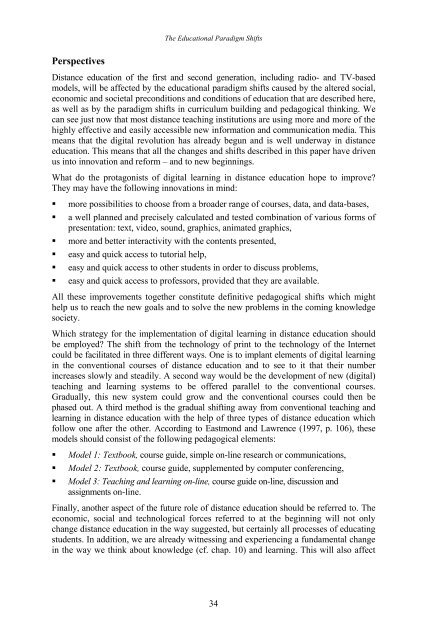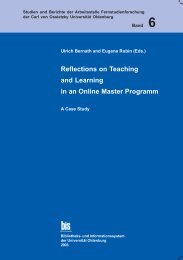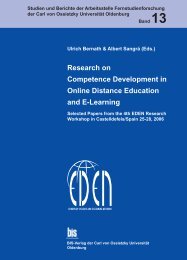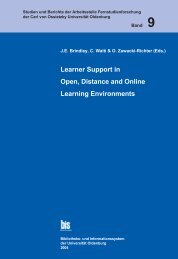Distance Education in Transition - Master of Distance Education ...
Distance Education in Transition - Master of Distance Education ...
Distance Education in Transition - Master of Distance Education ...
Create successful ePaper yourself
Turn your PDF publications into a flip-book with our unique Google optimized e-Paper software.
Perspectives<br />
The <strong>Education</strong>al Paradigm Shifts<br />
<strong>Distance</strong> education <strong>of</strong> the first and second generation, <strong>in</strong>clud<strong>in</strong>g radio- and TV-based<br />
models, will be affected by the educational paradigm shifts caused by the altered social,<br />
economic and societal preconditions and conditions <strong>of</strong> education that are described here,<br />
as well as by the paradigm shifts <strong>in</strong> curriculum build<strong>in</strong>g and pedagogical th<strong>in</strong>k<strong>in</strong>g. We<br />
can see just now that most distance teach<strong>in</strong>g <strong>in</strong>stitutions are us<strong>in</strong>g more and more <strong>of</strong> the<br />
highly effective and easily accessible new <strong>in</strong>formation and communication media. This<br />
means that the digital revolution has already begun and is well underway <strong>in</strong> distance<br />
education. This means that all the changes and shifts described <strong>in</strong> this paper have driven<br />
us <strong>in</strong>to <strong>in</strong>novation and reform – and to new beg<strong>in</strong>n<strong>in</strong>gs.<br />
What do the protagonists <strong>of</strong> digital learn<strong>in</strong>g <strong>in</strong> distance education hope to improve?<br />
They may have the follow<strong>in</strong>g <strong>in</strong>novations <strong>in</strong> m<strong>in</strong>d:<br />
� more possibilities to choose from a broader range <strong>of</strong> courses, data, and data-bases,<br />
� a well planned and precisely calculated and tested comb<strong>in</strong>ation <strong>of</strong> various forms <strong>of</strong><br />
presentation: text, video, sound, graphics, animated graphics,<br />
� more and better <strong>in</strong>teractivity with the contents presented,<br />
� easy and quick access to tutorial help,<br />
� easy and quick access to other students <strong>in</strong> order to discuss problems,<br />
� easy and quick access to pr<strong>of</strong>essors, provided that they are available.<br />
All these improvements together constitute def<strong>in</strong>itive pedagogical shifts which might<br />
help us to reach the new goals and to solve the new problems <strong>in</strong> the com<strong>in</strong>g knowledge<br />
society.<br />
Which strategy for the implementation <strong>of</strong> digital learn<strong>in</strong>g <strong>in</strong> distance education should<br />
be employed? The shift from the technology <strong>of</strong> pr<strong>in</strong>t to the technology <strong>of</strong> the Internet<br />
could be facilitated <strong>in</strong> three different ways. One is to implant elements <strong>of</strong> digital learn<strong>in</strong>g<br />
<strong>in</strong> the conventional courses <strong>of</strong> distance education and to see to it that their number<br />
<strong>in</strong>creases slowly and steadily. A second way would be the development <strong>of</strong> new (digital)<br />
teach<strong>in</strong>g and learn<strong>in</strong>g systems to be <strong>of</strong>fered parallel to the conventional courses.<br />
Gradually, this new system could grow and the conventional courses could then be<br />
phased out. A third method is the gradual shift<strong>in</strong>g away from conventional teach<strong>in</strong>g and<br />
learn<strong>in</strong>g <strong>in</strong> distance education with the help <strong>of</strong> three types <strong>of</strong> distance education which<br />
follow one after the other. Accord<strong>in</strong>g to Eastmond and Lawrence (1997, p. 106), these<br />
models should consist <strong>of</strong> the follow<strong>in</strong>g pedagogical elements:<br />
� Model 1: Textbook, course guide, simple on-l<strong>in</strong>e research or communications,<br />
� Model 2: Textbook, course guide, supplemented by computer conferenc<strong>in</strong>g,<br />
� Model 3: Teach<strong>in</strong>g and learn<strong>in</strong>g on-l<strong>in</strong>e, course guide on-l<strong>in</strong>e, discussion and<br />
assignments on-l<strong>in</strong>e.<br />
F<strong>in</strong>ally, another aspect <strong>of</strong> the future role <strong>of</strong> distance education should be referred to. The<br />
economic, social and technological forces referred to at the beg<strong>in</strong>n<strong>in</strong>g will not only<br />
change distance education <strong>in</strong> the way suggested, but certa<strong>in</strong>ly all processes <strong>of</strong> educat<strong>in</strong>g<br />
students. In addition, we are already witness<strong>in</strong>g and experienc<strong>in</strong>g a fundamental change<br />
<strong>in</strong> the way we th<strong>in</strong>k about knowledge (cf. chap. 10) and learn<strong>in</strong>g. This will also affect<br />
34





